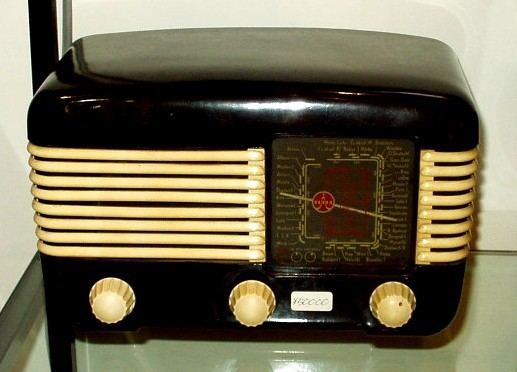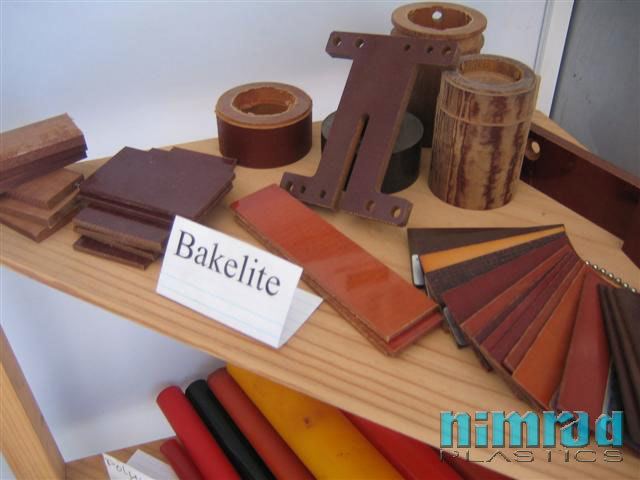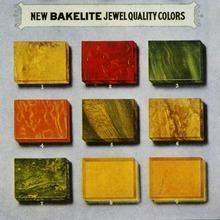Formula (C6-H6-O.C-H2-O)x Appearance Brown solid | Density 1.3 g/cm³ | |
 | ||
Agr chem bakelite using acidic catalyst
Bakelite (/ˈbeɪkəlaɪt/ BAY-kə-lyt, sometimes spelled Baekelite), or polyoxybenzylmethylenglycolanhydride, is an early plastic. It is a thermosetting phenol formaldehyde resin, formed from a condensation reaction of phenol with formaldehyde. It was developed by the Belgian-American chemist Leo Baekeland in Yonkers, New York, in 1907.
Contents
- Agr chem bakelite using acidic catalyst
- Making bakelite periodic table of videos
- History
- Synthesis
- Compression molding
- Phenolic sheet
- Properties
- Applications and usage
- Collectible status
- Patents
- Similar plastics
- References

One of the first plastics made from synthetic components, Bakelite was used for its electrical nonconductivity and heat-resistant properties in electrical insulators, radio and telephone casings and such diverse products as kitchenware, jewelry, pipe stems, children's toys, and firearms. The "retro" appeal of old Bakelite products has made them collectible.

Bakelite was designated a National Historic Chemical Landmark on November 9, 1993, by the American Chemical Society in recognition of its significance as the world's first synthetic plastic.

Making bakelite periodic table of videos
History

Baekeland was already wealthy, due to his invention of Velox photographic paper, when he began to investigate the reactions of phenol and formaldehyde in his home laboratory. Chemists had begun to recognize that many natural resins and fibres were polymers. Baekeland's initial intent was to find a replacement for shellac, a material that was in limited supply because it was made naturally from the excretion of lac insects (specifically Kerria lacca). Baekeland produced a soluble phenol-formaldehyde shellac called "Novolak", but it was not a market success.
Baekeland then began experimenting to strengthen wood by impregnating it with a synthetic resin, rather than coating it. By controlling the pressure and temperature applied to phenol and formaldehyde, Baekeland produced a hard moldable material which he named "Bakelite". It was the first synthetic thermosetting plastic ever produced, and Baekeland speculated on "the thousand and one ... articles" that it could be used to make. Baekeland considered the possibilities of using a wide variety of filling materials, including cotton, powdered bronze, and slate dust, but was most successful with wood and asbestos fibers.
Baekeland filed a substantial number of patents in the area. His "Method of making insoluble products of phenol and formaldehyde" was filed on July 13, 1907 and granted on December 7, 1909. Baekeland also filed for patent protection in other countries, including Belgium, Canada, Denmark, Hungary, Japan, Mexico, Russia, and Spain. He announced his invention at a meeting of the American Chemical Society on February 5, 1909.
Baekeland started semi-commercial production of his new material in his home laboratory, marketing it as a material for electrical insulators. By 1910, he was producing enough material to justify expansion. He formed the General Bakelite Company as a U.S. company to manufacture and market his new industrial material. He also made overseas connections to produce materials in other countries.
Bijker gives a detailed discussion of the development of Bakelite and the Bakelite Company's production of various applications of materials. As of 1911, the company's main focus was laminating varnish, whose sales volume vastly outperformed both molding material and cast resin. By 1912, molding material was gaining ground, but its sales volume for the company did not exceed that of laminating varnish until the 1930s.
As the sales figures also show, the Bakelite Company produced "Transparent" cast resin (which did not include filler) for a small ongoing market during the 1910s and 1920s. Blocks or rods of cast resin, also known as "artificial amber", were machined and carved to create items such as pipe stems, cigarette holders and jewelry. However, the demand for molded plastics led the Bakelite Company to concentrate on molding, rather than developing market opportunities for cast resins.
The Bakelite Corporation was formed in 1922 (after patent litigation favorable to Baekeland) from a merger of three companies: Baekeland's General Bakelite Company; the Condensite Company, founded by J.W. Aylesworth; and the Redmanol Chemical Products Company, founded by L.V. Redman. Under director of advertising and public relations Allan Brown, who came to Bakelite from Condensite, Bakelite was aggressively marketed as "The Material of A Thousand Uses". A filing for a trademark featuring the letter B above the mathematical symbol for infinity was made August 25, 1925, and claimed the mark was in use as of December 1, 1924. A wide variety of uses were listed in their trademark applications.
The first issue of Plastics magazine, October 1925, featured Bakelite on its cover, and included the article "Bakelite – What It Is" by Allan Brown. The range of colors available included "black, brown, red, yellow, green, gray, blue, and blends of two or more of these". The article emphasized that Bakelite came in various forms. "Bakelite is manufactured in several forms to suit varying requirements. In all these forms the fundamental basis is the initial Bakelite resin. This variety includes Clear Material, for jewelry, smokers' articles, etc.; cement, using in sealing electric light bulbs in metal bases; varnishes, for impregnating electric coils, etc.; lacquers, for protecting the surface of hardware; enamels, for giving resistive coating to industrial equipment; Laminated Bakelite, used for silent gears and insulation; and molding material, from which are formed innumerable articles of utility and beauty. The Molding Material is prepared ordinarily by the impregnation of cellulose substances with the initial 'uncured' resin." In a 1925 report, the United States Tariff Commission hailed the commercial manufacture of synthetic phenolic resin as "distinctly an American achievement", and noted that "the publication of figures, however, would be a virtual disclosure of the production of an individual company".
In England, Bakelite Limited, a merger of three British phenol formaldehyde resin suppliers (Damard Lacquer Company Limited of Birmingham, Mouldensite Limited of Darley Dale and Redmanol Chemical Products Company of London), was formed in 1926. A new Bakelite factory opened in Tyseley, Birmingham around 1928. It was demolished in 1998.
A new factory was opened in Bound Brook, New Jersey, in 1931. In 1939, the companies were acquired by Union Carbide and Carbon Corporation. Union Carbide's phenolic resin business including the Bakelite and Bakelit registered trademarks are owned by Momentive Specialty Chemicals.
In addition to the original Bakelite material, these companies eventually made a wide range of other products, many of which were marketed under the brand name "Bakelite plastics". These included other types of cast phenolic resins similar to Catalin, and urea-formaldehyde resins, which could be made in brighter colors than polyoxybenzylmethylenglycolanhydride.
Once Baekeland's heat and pressure patents expired in 1927, Bakelite Corporation faced serious competition from other companies. Because molded Bakelite incorporated fillers to give it strength, it tended to be made in concealing dark colors. In 1927, beads, bangles and earrings were produced by the Catalin Company, through a different process which enabled them to introduce 15 new colors. Translucent jewelry, poker chips and other items made of phenolic resins were introduced in the 1930s or 1940s by the Catalin Company under the Prystal name. The creation of marbled phenolic resins may also be attributable to the Catalin Company.
Synthesis
Making Bakelite was a multi-stage process. It began with the heating of phenol and formaldehyde in the presence of a catalyst such as hydrochloric acid, zinc chloride, or the base ammonia. This created a liquid condensation product, referred to as Bakelite A, which was soluble in alcohol, acetone, or additional phenol. Heated further, the product became partially soluble and could still be softened by heat. Sustained heating resulted in an "insoluble hard gum". However, the high temperatures required to create this tended to cause violent foaming of the mixture, which resulted in the cooled material being porous and breakable. Baekeland's innovative step was to put his "last condensation product" into an egg-shaped "Bakelizer". By heating it under pressure, at about 150 °C (300 °F), Baekeland was able to suppress the foaming that would otherwise occur. The resulting substance was extremely hard and both infusible and insoluble.
Compression molding
Molded Bakelite forms in a condensation reaction of phenol and formaldehyde, with wood flour or asbestos fiber as a filler, under high pressure and heat in a time frame of a few minutes of curing. The result is a hard plastic material.
Bakelite's molding process had a number of advantages. Bakelite resin could be provided either as powder, or as preformed partially cured slugs, increasing the speed of the casting. Thermosetting resins such as Bakelite required heat and pressure during the molding cycle, but could be removed from the molding process without being cooled, again making the molding process faster. Also, because of the smooth polished surface that resulted, Bakelite objects required less finishing. Millions of parts could be duplicated quickly and relatively cheaply.
Phenolic sheet
Another market for Bakelite resin was the creation of phenolic sheet materials. Phenolic sheet is a hard, dense material made by applying heat and pressure to layers of paper or glass cloth impregnated with synthetic resin. Cellulose paper, cotton fabrics, synthetic yarn fabrics, glass fabrics and unwoven fabrics are all possible materials used in lamination. When heat and pressure are applied, polymerization transforms the layers into thermosetting industrial laminated plastic.
Bakelite phenolic sheet is produced in many commercial grades and with various additives to meet diverse mechanical, electrical and thermal requirements. Some common types include:
Properties
Bakelite has a number of important properties. It can be molded very quickly, allowing identical units to be mass-produced. Moldings are smooth, retain their shape and are resistant to heat, scratches, and destructive solvents. It is also resistant to electricity, and prized for its low conductivity. It is not flexible.
Phenolic resin products may swell slightly under conditions of extreme humidity or perpetual dampness. When rubbed or burnt, Bakelite has a distinctive, acrid, sickly-sweet or fishy odor.
Applications and usage
These characteristics made Bakelite particularly suitable as a molding compound, an adhesive or binding agent, a varnish, and as a protective coating. Bakelite was particularly suitable for the emerging electrical and automobile industries because of its extraordinarily high resistance to electricity, heat and chemical action.
The earliest commercial use of Bakelite in the electrical industry was the molding of tiny insulating bushings the size of mustard seeds, made in 1908 for the Weston Electrical Instrument Corporation by Richard W. Seabury of the Boonton Rubber Company. Bakelite was soon used for non-conducting parts of telephones, radios and other electrical devices, including bases and sockets for light bulbs and electron tubes, supports for any type of electrical components, automobile distributor caps and other insulators. By 1912, it was being used to make billiard balls, since its elasticity and the sound it made were similar to ivory.
During World War I, Bakelite was used widely for machine parts, particularly electrical systems. Important projects included the Liberty Motor, the wireless telephone and radio phone and the use of micarta-bakelite propellors in the NBS-1 bomber and the DH-4B aeroplane.
Bakelite's availability and ease and speed of molding helped to lower the costs of production and increase product availability so that both telephones and radios became common household consumer goods. It was also very important to the developing automobile industry. It was soon found in myriad other consumer products ranging from pipe stems and buttons to saxophone mouthpieces, cameras, early machine guns, and appliance casings.
Beginning in the 1920s, it became a popular material for jewelry. Designer Coco Chanel included Bakelite bracelets in her costume jewelry collections. Designers such as Elsa Schiaparelli used it for jewelry and also for specially designed dress buttons. Later, Diana Vreeland, editor of Vogue, was enthusiastic about Bakelite. Bakelite was also used to make presentation boxes for Breitling watches. Jewelry designers such as Jorge Caicedo Montes De Oca still use vintage Bakelite materials to make designer jewelry.
By 1930, designer Paul T. Frankl considered Bakelite a "Materia Nova", "expressive of our own age". By the 1930s, Bakelite was used for game pieces like chessmen, poker chips, dominoes and mahjong sets. Kitchenware made with Bakelite, including canisters and tableware, was promoted for its resistance to heat and to chipping. In the mid-1930s, Northland marketed a line of skis with a black "Ebonite" base, a coating of Bakelite. By 1935, it was used in solid-body electric guitars. Performers such as Jerry Byrd loved the tone of Bakelite guitars but found them difficult to keep in tune.
The British children's construction toy Bayko, launched in 1933, originally used Bakelite for many of its parts, and took its name from the material.
During World War II, Bakelite was used in a variety of wartime equipment including pilot's goggles and field telephones. It was also used for patriotic wartime jewelry. In 1943, the thermosetting phenolic resin was even considered for the manufacture of coins, due to a shortage of traditional material. Bakelite and other non-metal materials were tested for usage for the one cent coin in the US before the Mint settled on zinc-coated steel.
In 1947, Dutch art forger Han van Meegeren was convicted of forgery, after chemist and curator Paul B. Coremans proved that a purported Vermeer contained Bakelite, which van Meegeren had used as a paint hardener.
Bakelite was sometimes used as a substitute for metal in the magazine, pistol grip, fore grip, hand guard, and butt stock of firearms. Some early AK-74 rifles have been identified as using Bakelite, but most were made with AG-S4, commonly mistaken for Bakelite.
By the late 1940s, newer materials were superseding Bakelite in many areas. Phenolics are less frequently used in general consumer products today due to their cost and complexity of production and their brittle nature. They still appear in some applications where their specific properties are required, such as small precision-shaped components, molded disc brake cylinders, saucepan handles, electrical plugs, switches and parts for electrical irons, as well as in the area of inexpensive board and tabletop games produced in China, Hong Kong and India. Items such as billiard balls, dominoes and pieces for board games like chess, checkers, and backgammon are constructed of Bakelite for its look, durability, fine polish, weight, and sound. Common dice are sometimes made of Bakelite for weight and sound, but the majority are made of a thermoplastic polymer such as acrylonitrile butadiene styrene (ABS). Bakelite continues to be used for wire insulation, brake pads and related automotive components, and industrial electrical-related applications. Bakelite stock is still manufactured and produced in sheet, rod and tube form for industrial applications in the electronics, power generation and aerospace industries, and under a variety of commercial brand names.
Phenolic resins have been commonly used in ablative heat shields. Soviet heatshields for ICBM warheads and spacecraft reentry consisted of asbestos textolite, impregnated with Bakelite. Bakelite is also used in the mounting of metal samples in metallography.
Collectible status
Bakelite items, particularly jewelry and radios, have become a popular collectible. The term Bakelite is sometimes used in the resale market to indicate various types of early plastics, including Catalin and Faturan, which may be brightly colored, as well as items made of Bakelite material.
Patents
The United States Patent and Trademark Office granted Baekeland a patent for a "Method of making insoluble products of phenol and formaldehyde" on December 7, 1909. Producing hard, compact, insoluble and infusible condensation products of phenols and formaldehyde marked the beginning of the modern plastics industry.
Similar plastics
Catalin was also a phenolic resin, similar to Bakelite, but contained different mineral fillers that allowed the production of light colors. Condensites are similar thermoset materials having much the same properties, characteristics, and uses. Crystalate was an early plastic. Faturan is phenolic resin, also similar to Bakelite, that turns red over time, regardless of its original color. Galalith is an early plastic derived from milk products. Micarta is an early composite insulating plate that used Bakelite as a binding agent. It was trademarked in 1912 by Westinghouse Elec. & Mfg Co. Novotext is a brand name for cotton textile-phenolic resin.
